
Forking a Sketch: How the OpenProcessing Community Uses Remixing to Collect, Annotate, Tune, and Extend Creative Code
Blair Subbaraman, Shenna Shim, Nadya Peek
Machine Agency, University of Washington
Slides: https://rb.gy/3jdyb
What remixing strategies do creative coders employ to reuse code?
Remixing Creative Code





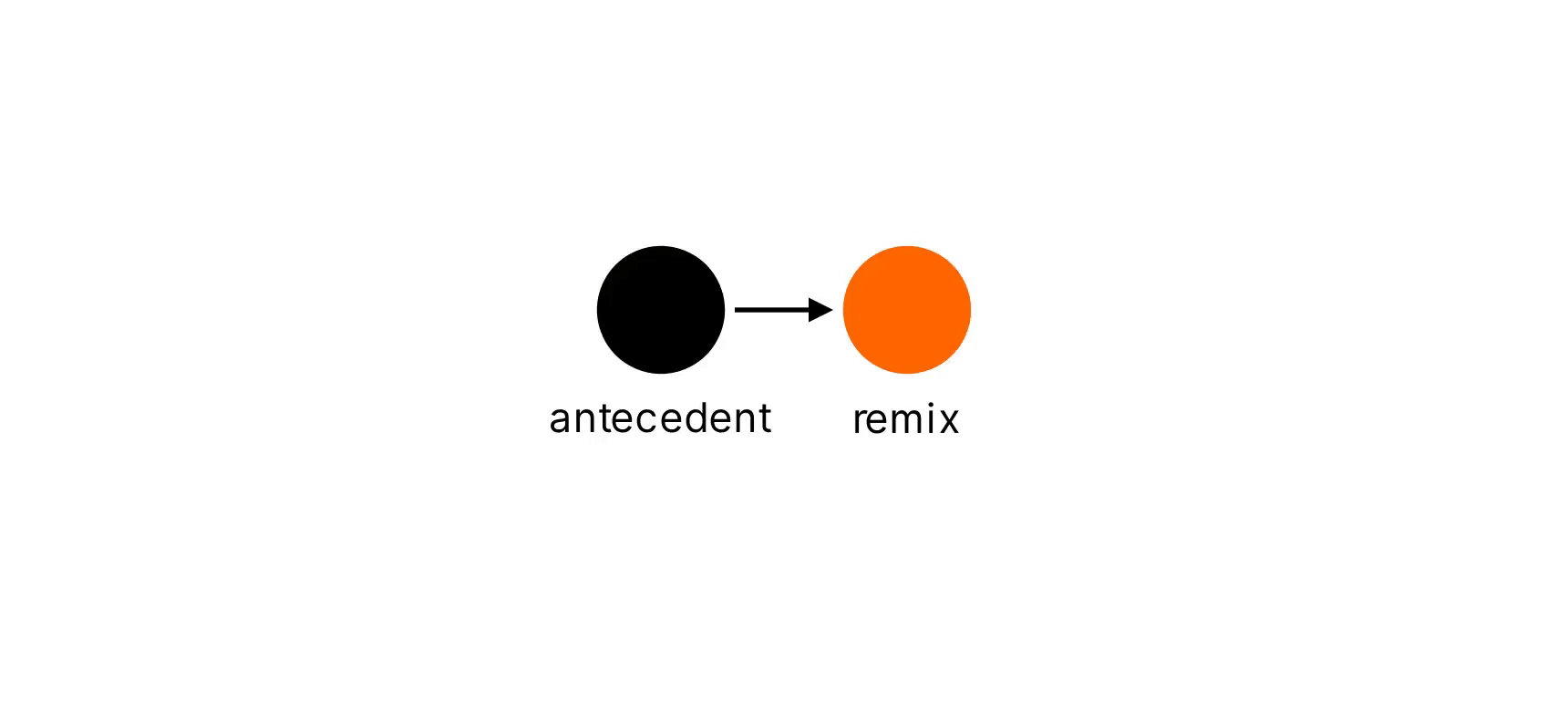


Understanding High-Level Remixing Practices
- Dataset
- 1.2 million sketches available
- 336,069 sketches in remixing graph
- 30% of all sketches
- Dataset
- 1.2 million sketches available
- 336,069 sketches in remixing graph
- 30% of all sketches
- Network Analysis
- 79,453 subgraphs
- 2749 nodes in largest subgraph
- 49% of all remixes are self-remixes
Antecedent-Remix Pairs: A Worked Example
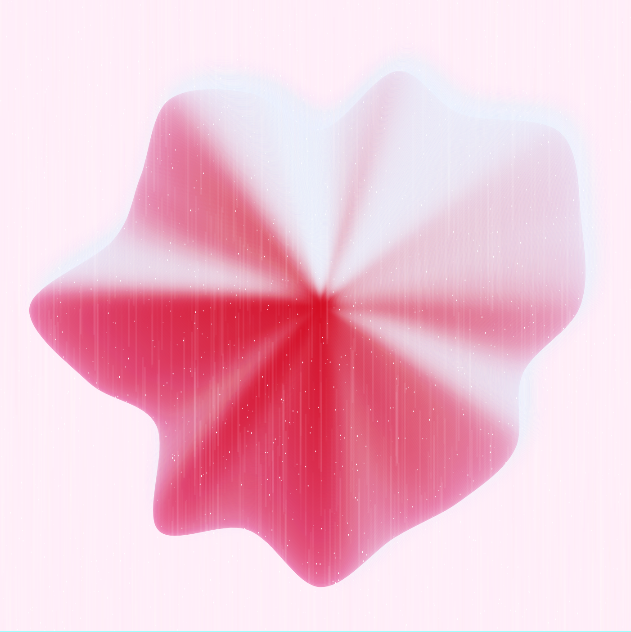
function myCircle (x, y, rad) {
let numLayers = 200
for (let i = 0; i < numLayers; i++) {
let vertices = []
for (let theta = 0; theta < TAU; theta += TAU / 20) {
...
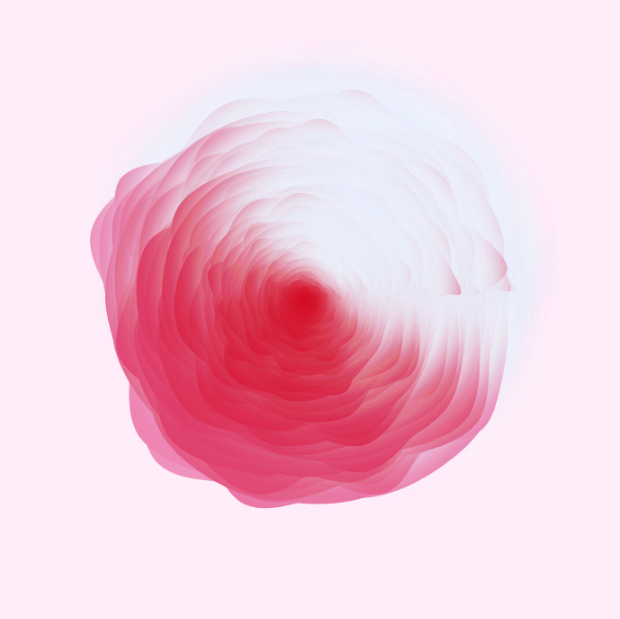
function myCircle (x, y, rad) {
let numLayers = random(100, 300)
for (let i = 0; i < numLayers; i++) {
let vertices = []
let flick = random(10,11)
// for (let theta = 0; theta < TAU; theta += TAU / random(10,30)) {
for (let theta = 0; theta < TAU; theta += TAU / flick) {
...

function myCircle (x, y, rad) {
let numLayers = 200
for (let i = 0; i < numLayers; i++) {
let vertices = []
for (let theta = 0; theta < TAU; theta += TAU / 20) {
...

function myCircle (x, y, rad) {
let numLayers = random(100, 300)
for (let i = 0; i < numLayers; i++) {
let vertices = []
let flick = random(10,11)
// for (let theta = 0; theta < TAU; theta += TAU / random(10,30)) {
for (let theta = 0; theta < TAU; theta += TAU / flick) {
...

function myCircle (x, y, rad) {
let numLayers = 200
for (let i = 0; i < numLayers; i++) {
let vertices = []
for (let theta = 0; theta < TAU; theta += TAU / 20) {
...

function myCircle (x, y, rad) {
let numLayers = random(100, 300)
for (let i = 0; i < numLayers; i++) {
let vertices = []
let flick = random(10,11)
// for (let theta = 0; theta < TAU; theta += TAU / random(10,30)) {
for (let theta = 0; theta < TAU; theta += TAU / flick) {
...
tuning

function myCircle (x, y, rad) {
let numLayers = 200
for (let i = 0; i < numLayers; i++) {
let vertices = []
for (let theta = 0; theta < TAU; theta += TAU / 20) {
...

function myCircle (x, y, rad) {
let numLayers = random(100, 300)
for (let i = 0; i < numLayers; i++) {
let vertices = []
let flick = random(10,11)
// for (let theta = 0; theta < TAU; theta += TAU / random(10,30)) {
for (let theta = 0; theta < TAU; theta += TAU / flick) {
...
tuning, extending

function myCircle (x, y, rad) {
let numLayers = 200
for (let i = 0; i < numLayers; i++) {
let vertices = []
for (let theta = 0; theta < TAU; theta += TAU / 20) {
...

function myCircle (x, y, rad) {
let numLayers = random(100, 300)
for (let i = 0; i < numLayers; i++) {
let vertices = []
let flick = random(10,11)
// for (let theta = 0; theta < TAU; theta += TAU / random(10,30)) {
for (let theta = 0; theta < TAU; theta += TAU / flick) {
...
tuning, extending, annotating
tuning, extension, annotation
collecting, tuning, extending, annotating
Collecting

Annotating
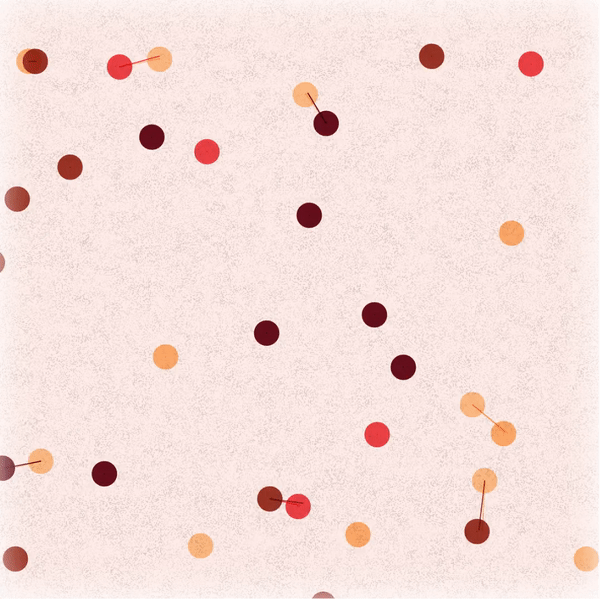
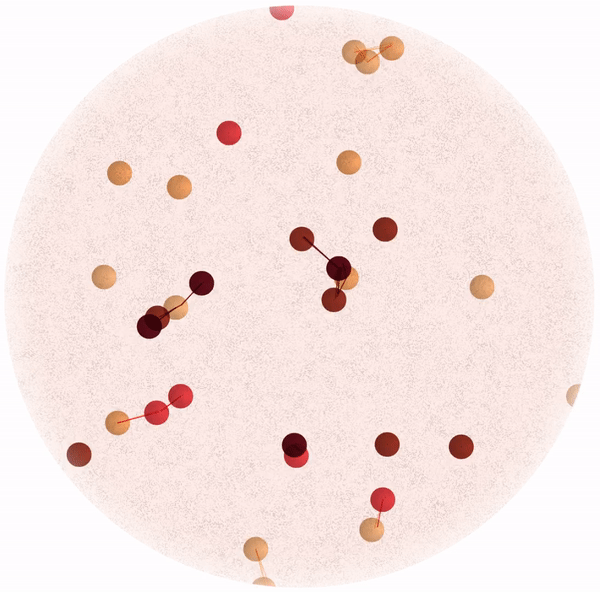
/*
ok, this texture algorithm I definitely stole. 98% sure it was from
**Che-Yu Wu (openprocessing.org/user/139364)** an amazingly talented
artist, who also adds lots of in-progress stuff to openProcessing-
nice to learn from (not that I learned from this at the time I made this,
so much as I copied and pasted it) creates a nice papery texture by applying
noise to the pixel array, that is blended with the rest of the ’art’ later on.
*/


/*
ok, this texture algorithm I definitely stole. 98% sure it was from
**Che-Yu Wu (openprocessing.org/user/139364)** an amazingly talented
artist, who also adds lots of in-progress stuff to openProcessing-
nice to learn from (not that I learned from this at the time I made this,
so much as I copied and pasted it) creates a nice papery texture by applying
noise to the pixel array, that is blended with the rest of the ’art’ later on.
*/
var length = 150; var length = 100; // 150
Tuning

margin = mySize / 100;
for (let i=0; i < int(random(50, 100) ); i++) { ... }
theShader.setUniform('u_time ', millis () / 1000);
let version = random ([1 ,2 ,4 ,6 ,8]) * 100;
let c = random (2000 , 5000) ;
colorMode(HSB, 360, 100, 100, 100);

margin = mySize / 10;
for (let i=0; i < int(random(500, 100) ); i++) { ... }
theShader.setUniform('u_time', millis () / 1);
let version = random ([200,150,77,50,140] * 100;
let c = random (1000, 2000);
colorMode(HSB, 21, 10, 10, 10);

margin = mySize / 100;
for (let i=0; i < int(random(50, 100) ); i++) { ... }
theShader.setUniform('u_time ', millis () / 1000);
let version = random ([1 ,2 ,4 ,6 ,8]) * 100;
let c = random (2000 , 5000) ;
colorMode(HSB, 360, 100, 100, 100);
stroke (244 , 37 , 37 , 60); // red

margin = mySize / 10;
for (let i=0; i < int(random(500, 100) ); i++) { ... }
theShader.setUniform('u_time', millis () / 1);
let version = random ([200,150,77,50,140] * 100;
let c = random (1000, 2000);
colorMode(HSB, 21, 10, 10, 10);
stroke (0, 0, 0); // red
Extending
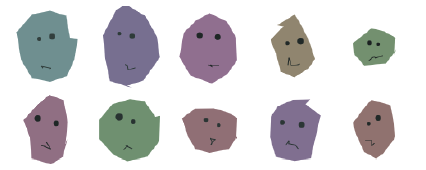
vertex(xPosition , yPosition);
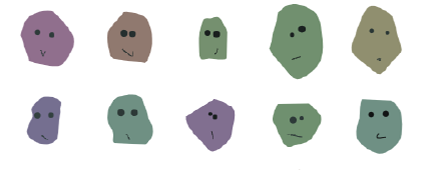
curveVertex(xPosition,yPosition);

function randomShape(x_, y_, w_, h_, col) {
let grfx = createGraphics(w_, h_);
let rnd = int(random(6));
let num = int(random(1, 4));
...
for (let i = 0; i < num; i++) {
let w = random(5, w_ * 0.35);
let h = random(5, h_ * 0.35);
let x = (random(1.4)-0.2)*grfx.width;
let y = (random(1.4)-0.2)*grfx.height;
...
}
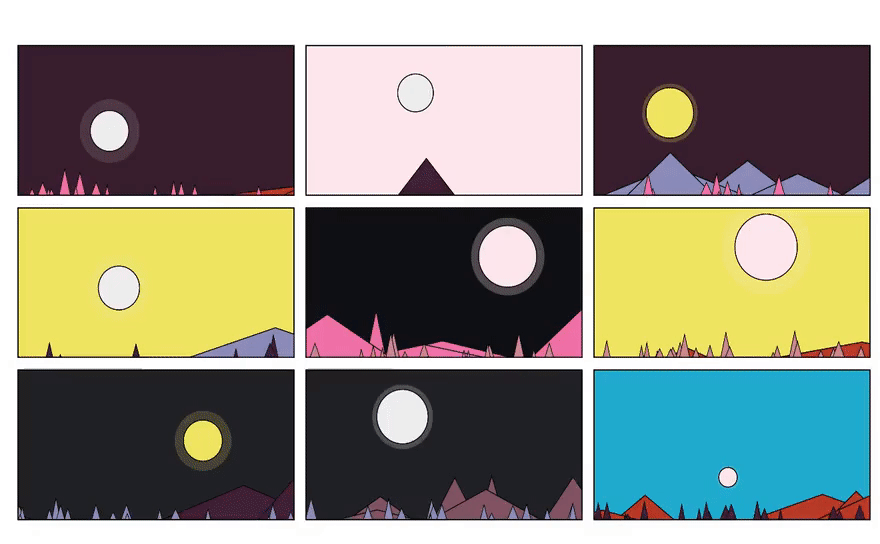
function drawTrees(x_, y_, w_, h_, col) {
let grfx = createGraphics (w_, h_);
count = int(random(30));
...
for (let i = 0; i < count; i++) {
let w = random(2, 10);
let h = w * random (2, 5);
let x = (random(1.4) - 0.2) * grfx.width;
let y = (random(1.4) - 0.2) * grfx.height;
...
};
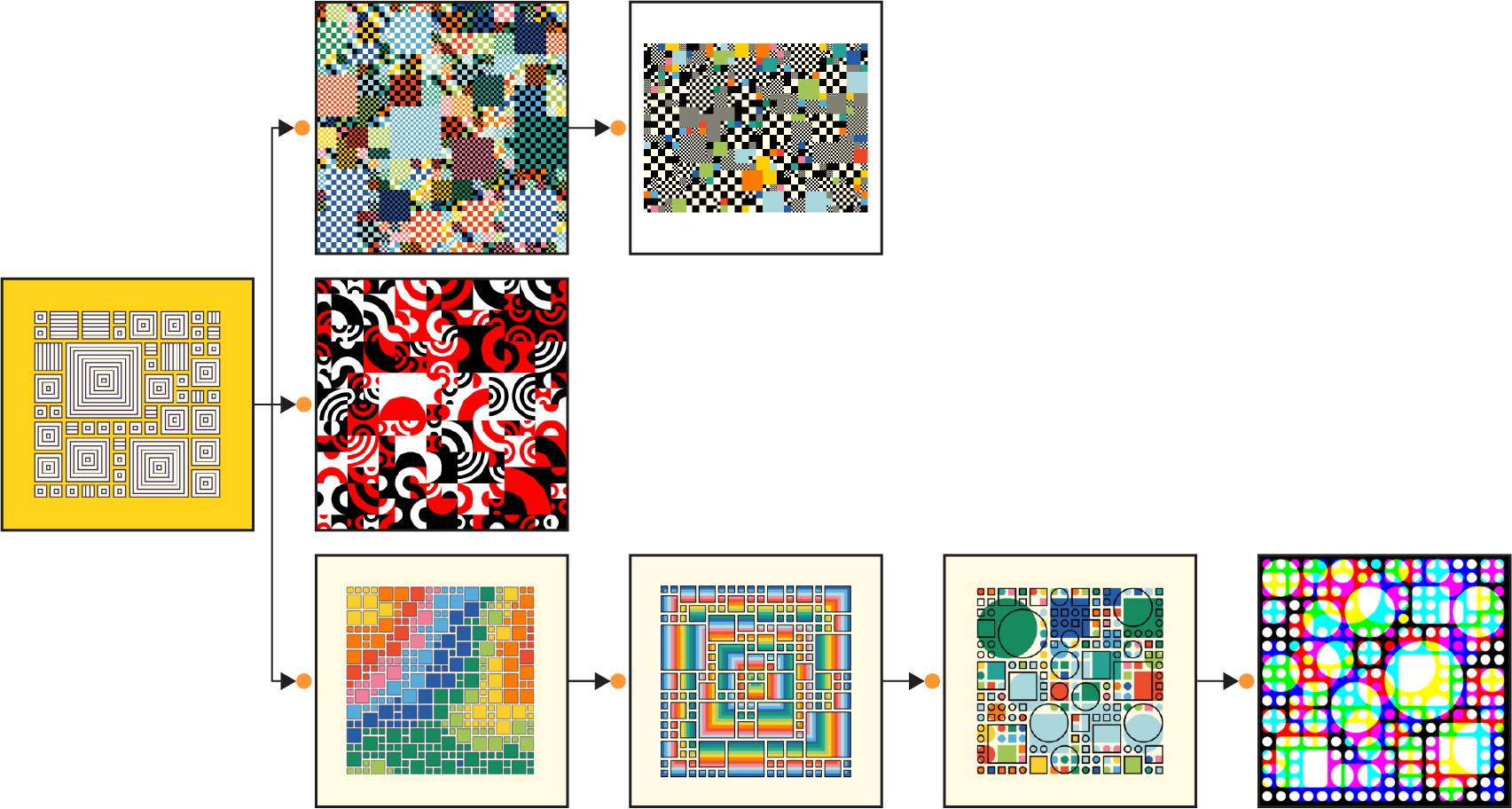
Key Takeaways
- Understanding Existing Creative Communities
- Design Provocations
- Applicability to Other Contexts
- Understanding Existing Creative Communities
- Design Provocations
- Applicability to Other Contexts
- Understanding Existing Creative Communities
- Design Provocations
- Applicability to Other Contexts
Special thanks to the OpenProcessing, Processing, and p5.js communities, and especially the authors who agreed to share their work for this paper:
Roni Kaufman, caaatisgood, Taiki Saito, Owaun Scantlebury, Richard Bourne, Neill Bogie, Naoki Tsutae, Aaron Reuland (a_soluble_fish), Naha, SamuelYAN, Trrrrrr, Sasha T. (@tequibo), shrike, Raven Kwok, Jason Labbe, Okazz, JFrench, garabotospr, Hans Peter, and Sayama
Forking a Sketch: How the OpenProcessing Community Uses Remixing to Collect, Annotate, Tune, and Extend Creative Code
Blair Subbaraman, Shenna Shim, Nadya Peek
Machine Agency, University of Washington
Slides: https://rb.gy/3jdyb